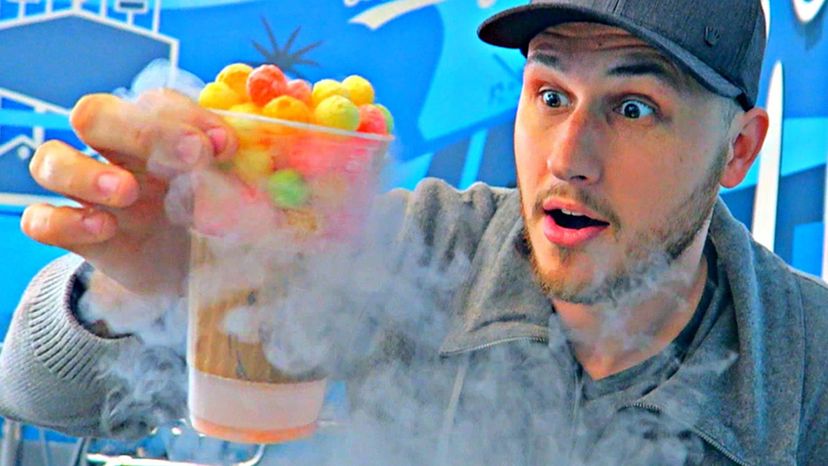 “Liquid nitrogen can easily blister fingers and hands, and ingesting it can cause serious damage to the mouth, esophagus and stomach. Taras Kul/YouTube screen shot/howstuffworks
“Liquid nitrogen can easily blister fingers and hands, and ingesting it can cause serious damage to the mouth, esophagus and stomach. Taras Kul/YouTube screen shot/howstuffworks
The modern American is living in a late capitalist wonderland. In these heady times, Gwyneth Paltrow can tell you what your spirit animal is and sell you a $2,800 insignia ring so you’ll never forget it. At Whole Foods you can purchase a 16 ounce plastic bottle of water with three stalks of raw asparagus floating in it for $6. You can buy a scratching pad for your cat on Amazon shaped like a turntable so she looks like a DJ when she sharpens her claws.
You may be of the opinion that these products are stupid and pointless and a waste of money, but they’re not dangerous, right? That may be true, but some of the things we buy to keep us entertained are more innocuous than others. Take "dragon’s breath cereal," a novelty snack that showed up in Southeast Asia in 2009. In the U.S. you can buy it at a carnival or one of those mall kiosks — it’s just cereal steeped in liquid nitrogen. When you pop the cereal in your mouth, the liquid nitrogen instantly freezes your saliva, making dense gray "smoke" pour out of your nose and mouth. Not a bad activity for a rainy day at the mall.
Liquid nitrogen is nitrogen gas that’s been pressurized and cooled to a frosty minus 320 F (minus 196 C). This is not the first time we’ve thought to use liquid nitrogen to make our food more interesting — you can do a lot of weird stuff with it, like flash-freezing an almost-cooked hamburger and then deep-frying it for the perfect crispy crust. We use it in medicine, too — it’s great for all kinds of stuff, from freezing sperm to removing warts.
Liquid nitrogen is pretty easy to come by, and the use of it in food and medicine has become pretty standard. So when we see a "dragon puffs" stand at the county fair and we’ve got $5 burning a hole in our pocket, a lot of us just shrug and say something like, "welp, I’ll try anything once!" and start puffing away on those cereal-cicles.
But listen: Liquid nitrogen is very cold. It is not toxic, but it freezes anything it touches on contact, including human tissue. It’s also an asphyxiant, which means it can displace the normal oxygen content in the air, which can lead to suffocation. In laboratory, medical or even professional kitchen settings, it’s pretty safe to handle, given the user is applying a modicum of common sense to the situation. But if you’re just guzzling a cocktail containing liquid nitrogen, made by some random bartender who is not a trained safety professional, there’s a chance it might kill some of your stomach lining and the gastric acid in your stomach could perforate your stomach, as happened to one woman in the U.K. in 2012.
And while not everyone who consumes liquid nitrogen is going to get hurt, uneducated consumers (like children) might because they don’t know what they’re dealing with. For instance, a 14-year-old girl in Florida was severely burned when her thumb came in contact with the liquid nitrogen at the bottom of a cup of dragon puffs, for instance. And liquid nitrogen can damage tissue in the airways: One Florida mother posted to Facebook a now-viral story about her 7-year-old son who experienced a serious asthma attack after trying the treat at a "Dragon’s Breath" kiosk in a Jacksonville, Florida, mall. A man in South Carolina has sued a Dragon’s Breath kiosk after his mouth filled with blood while eating the snack. The liquid nitrogen burned a hole in the side of his mouth, and the man is suing because the kiosk didn’t provide information about the potential risks of their product.
Safety first, everybody! Maybe use that $5 at Claire’s Boutique instead?
Now That’s Interesting
Dippin’ Dots, everybody’s favorite novelty ice cream, is flash-frozen with liquid nitrogen.


